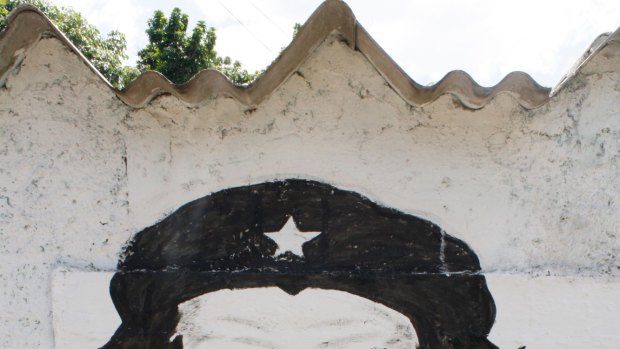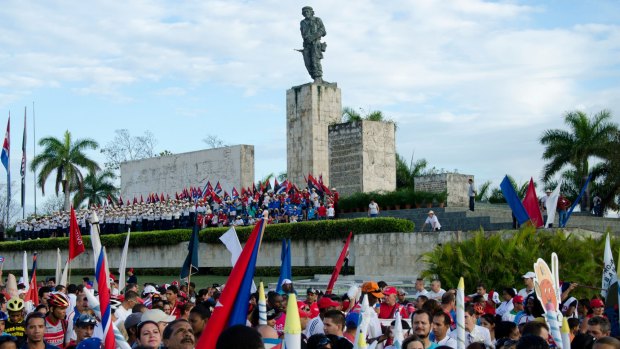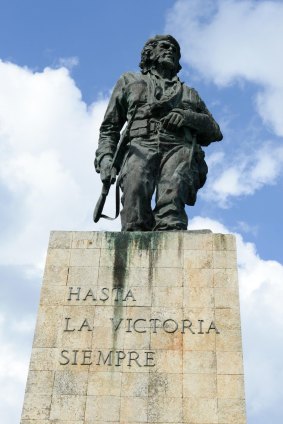
Che Guevara painted on a wall in Havana, Cuba.Credit: Alamy
It's the intensity of the stare that really gets you – an intensity that stirred men and women to pick up arms and fight, that inspired a revolution, that fuelled the socialist fantasies of university students the world over (most of whom, admittedly, would go on to do nothing more radical than buy a T-shirt).
Che Guevara. You only need to look at that iconic photo taken more than 50 years ago to feel a small part of what drove so many people to follow the Argentinian doctor once known as Ernesto into battle. It's that intense stare that speaks of passion, of heroism, and of inevitable demise.
And it's everywhere. Even in Cuba today. Even as you walk the streets of Havana you can't avoid the penetrating eyes of Che Guevara.

May Day celebrations at the Che Guevara Memorial in Santa Clara.Credit: Alamy
Those eyes are graffitied on the capital's decaying walls. They're posted large on its government buildings. And they're staring at you from the thousands of T-shirts hung on racks at the tourist stands.
Che Guevara lives large. The man himself would probably be horrified to see it, but he's become a brand, a tourist attraction. People come to this fascinating little island to learn more about the soldier behind the revolution; the man behind the stare.
I too have come to follow in Che's footsteps, to see the sites at which he forged his place in history. It's impossible to separate the Cuba of today with the deeds of Che Guevara. You have to see where it all started.

Statue at the Che Guevara Mausoleum, Santa Clara. Credit: Alamy
The natural first stop on that journey is also one of the easiest to find: a small yacht called Granma. This was the boat that transported Che, Fidel Castro, Raul Castro and 79 others from Mexico to the southeastern coast of Cuba in 1956, and it still holds a strong place in most Cubans' hearts.
Today, it sits encased in glass near the Museum of the Revolution in central Havana. Machine-gun-toting soldiers stand guard 24 hours a day as tourists gawk and locals shuffle past.
It was 60 years ago almost to the day that Che, Fidel and Raul boarded this yacht and began their mission to wrest power from the US-backed government of Fulgencio Batista. The plaques nearby don't say so, but it was a rash plan that almost ended in disaster. Guerillas got seasick, food was scarce and when the soldiers eventually landed it was in the wrong spot. The revolution was almost over before it had properly began.
But Fidel survived, Raul survived, Che survived, and even the Granma survived. The place where it landed, Playa Las Coloradas in the country's far south, is now beautifully peaceful, a part of the heritage-listed national park Desembarco del Granma. Tourists go there these days to hike through the forest, or swim below waterfalls, or paddle in the ocean.
Che's guerillas didn't hang around though, moving quickly into the mountains of the Oriente province, where they would spend the next three years gathering support for their revolution.
The next time tourists can meet up with Che and his rebels is in the central Cuban city of Santa Clara, where the soldier made his mark, and the tide of history turned for the revolutionaries.
It's baking hot the day I walk around Santa Clara's main square – a hive of activity as office workers grab lunch on the run – where the remnants of Che's revolution are still visible. This is where one of the main battles between the guerillas and Batista's forces played out, and there are still bullet holes in the walls of the Hotel Santa Clara Libre on the edge of the square.
Nearby, tourists can visit the wreckage of the Tren Blindado, the armoured train carrying soldiers and reinforcements sent by Batista that was ultimately derailed by the revolutionaries. That was the point at which the battle was won. Che's famous slogan that is still seen scrawled on walls throughout the city – "Hasta la victoria, siempre"; onwards to victory, always – finally rang true.
Santa Clara was the site of Che's greatest victory, and it's also his final resting place. Though Che would go on to be murdered in the jungles of Bolivia, his remains were transferred back to Cuba in 1997 and are now housed in a mausoleum on the outskirts of town.
It's a solemn place, the mausoleum, where as many Cubans come to pay their respects as foreign tourists visit out of curiosity. Inside it's dark and unadorned but for a few red stars to mark the remains of Che and his accomplices on that fateful foray.
Outside, a statue stands tall above the mausoleum. It's different to that famous photo, an older version of Che the soldier. But you still recognise that beret, that face, and the intensity of that stare.
TRIP NOTES
MORE INFORMATION
chimuadventures.com/destinations/central-america/cuba
GETTING THERE
LATAM Airlines offers seven one-stop flights a week from Sydney to Santiago, Chile. There are then connections on LATAM to Lima and onwards to Havana. Call 1800 126 038, or see latam.com.
TOURING THERE
Chimu Adventures offers all-inclusive travel packages for Cuba that include all of the sights relating to Che Guevara. Eight-day tours start from $999 a person. Call 1800 452 719 or see website above.
Ben Groundwater travelled as a guest of Chimu Adventures and LATAM Airlines.
Sign up for the Traveller Deals newsletter
Get exclusive travel deals delivered straight to your inbox. Sign up now.